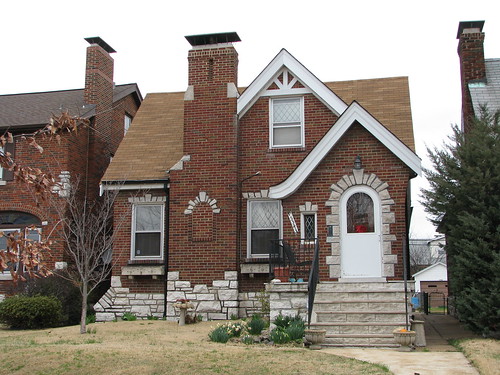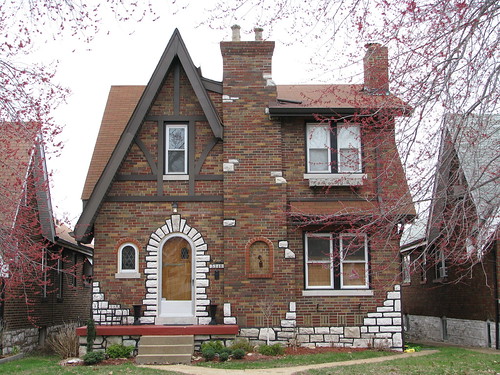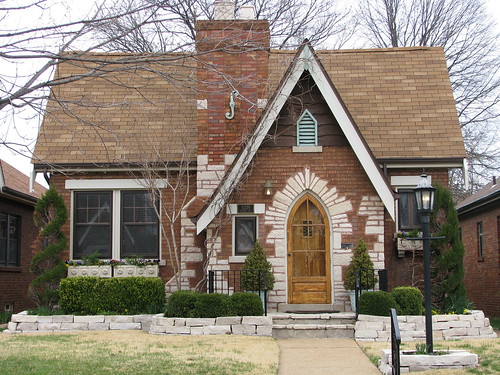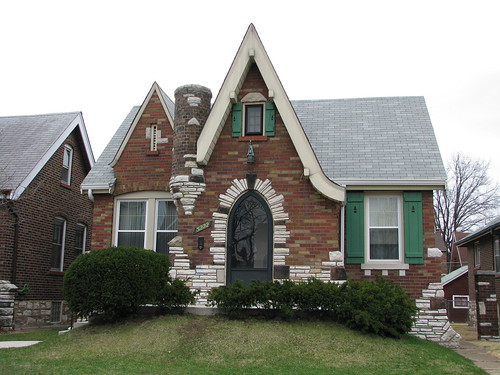Anyhow, I was reading the section on Tudor Revival and saw St. Louis's offerings prominently featured. I could tell the house was a Northampton (possibly Southampton or Lindenwood Park) beauty--a dominating front gable that dramatically plunged down to the entryway. It also had the requisite "gingerbread" frosting along the foundation and framing the windows, doors, and corners. Most in St. Louis are familiar with this type of house, which occurs quite often in neighborhoods that were built up between 1915 and 1935.
No neighborhood seems to embrace the style quite as ubiquitously as Northampton, though. Luckily, despite my inability to secure my own pictures, Doug Duckworth has me covered! He recently took a photo tour of Northampton in the area around the amazing La Tropicana and the wonderful World Cafe.

I failed to mention how these homes often exaggerate their chimneys, but this picture has served me well in conveying this.

Aha! Another Tudor Revival feature: the false half-timbering. Those decorative timbers are not structural, but were meant to evoke their older English counterparts.

The Gothic arch doorway is a nice detail, though not typical to Tudor Revival.

Notice the tiny window in the lesser gable and, of course, the swooping and front-and-center gable that screams Tudor. As if to spite me, this one has a Gothic-arched door as well, though it's not quite as pronounced.
I won't pillage all of Doug's collection; you must visit the rest here.
But just thinking to how there are entire blocks of these "Hansel and Gretel" houses made me believe it's about time to add this charming neighborhood to the National Register. My suggestion for a name: Southwest St. Louis Tudor Revival Historic District. Or Northampton Tudor Historic District. I suppose the name Northampton only adds to the tribute to our neighbors across the pond.
This style was so popular in the early and middle 20th century that we were lucky enough to see whole neighborhoods of them. While perhaps neighborhoods like Northampton lack the gritty urbanism and architectural diversity of the neighborhoods to the east, it is hard to argue that these rows of frosted gables, tiny casement windows, rustic shutters, half-timbering--and yes, the stained glass!--are somehow unattractive.
Take a stroll down Lindenwood, or Pernod, or Fairview, or any number of Northampton streets and tell me you're not impressed by the playful intimacy of these little cottages.



9 comments:
Ah, my old neighborhood. The house across the street from my old place looks just like the first house - a fairly common design for North Hampton.
I think the photos you featured are of Mardel, just east of Macklind.
Good eye. I admit that this is a part of the city I grew up near, and yet, never paid as much attention to the built environment as I did neighborhoods I considered more exciting (Tower Grove East, Lafayette Square, Old North, etc.)
Well, after visiting the more exciting areas, I really have come to appreciate the surrounding areas. It certainly has merit well beyond anything being built out west, or perhaps at the intersection of Arsenal and 59th (Parc Ridge Estates). These homes aren't the biggest, but they have a density of character largely bereft from many newer homes being constructed today. I would love to see an historic district and I'm sure citizens would appreciate such a designation.
The homes West of Hampton, North of Chippewa, South of Filer, and East of Watson are nice too. Perhaps I'll get over there and take some photos.
Anyone looking to buy? :)
http://www.cbgundaker.com/search/advanced/detail.jsp?mls_num=80020674&type=res
Wow! 259,9? Things are looking up for SW City, huh?
These houses are not Tudor -- they're a style called Cottswold Cottage, if my understanding is right. I've never heard this style called Tudor before in my life.
well isn't this fun - 2 anonymous posts in a row only a few weeks apart, but coming 2+ years after the discussion actually ended. What can I say, I love adding to the conversation...
But I feel I must speak up, as cotswold cottage is actually a subset of tudor style, so it's not at all a reach to call these types of homes tudor style.
I would like to see more of Doug Duckworth's photos but the link to his Flickr account is private, how do I view the additional home images?
thanks,
Sam
Post a Comment